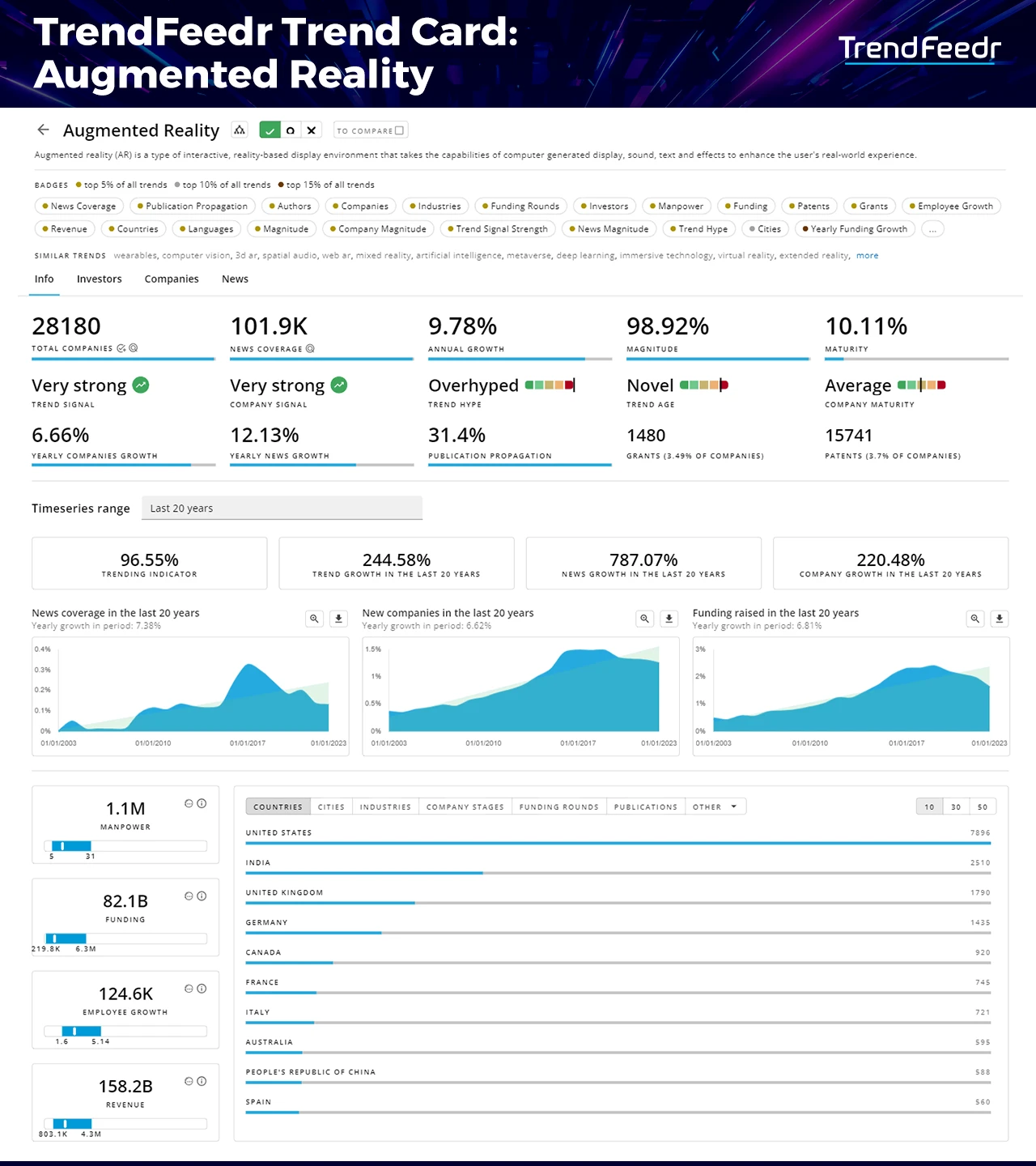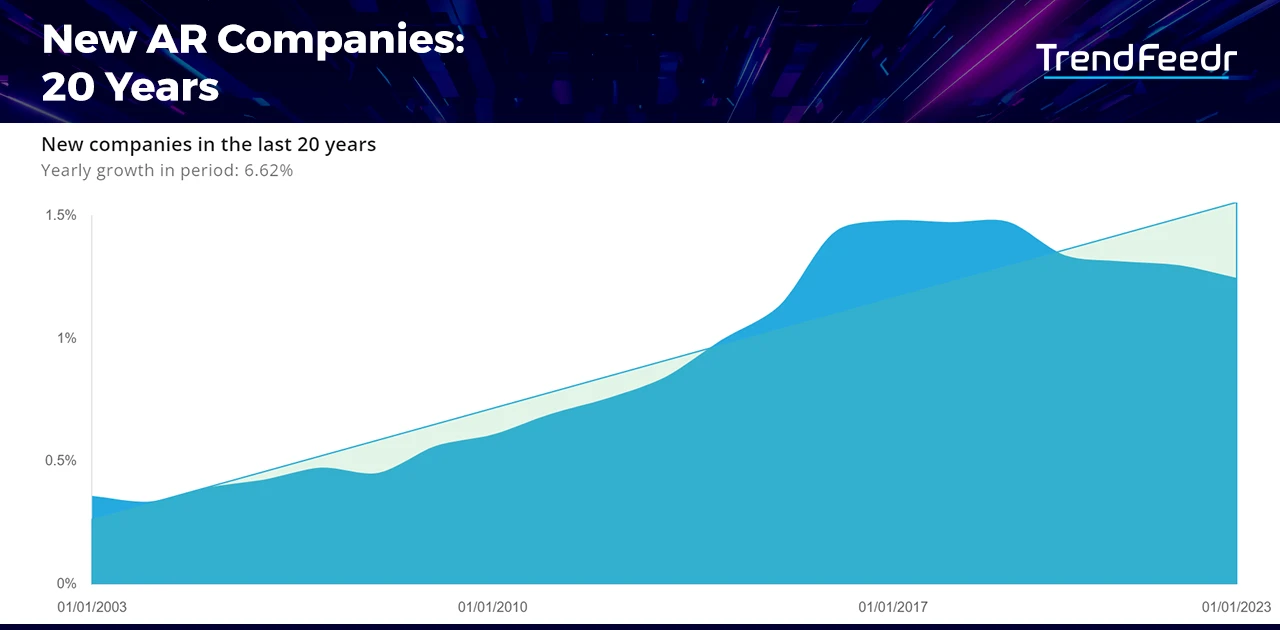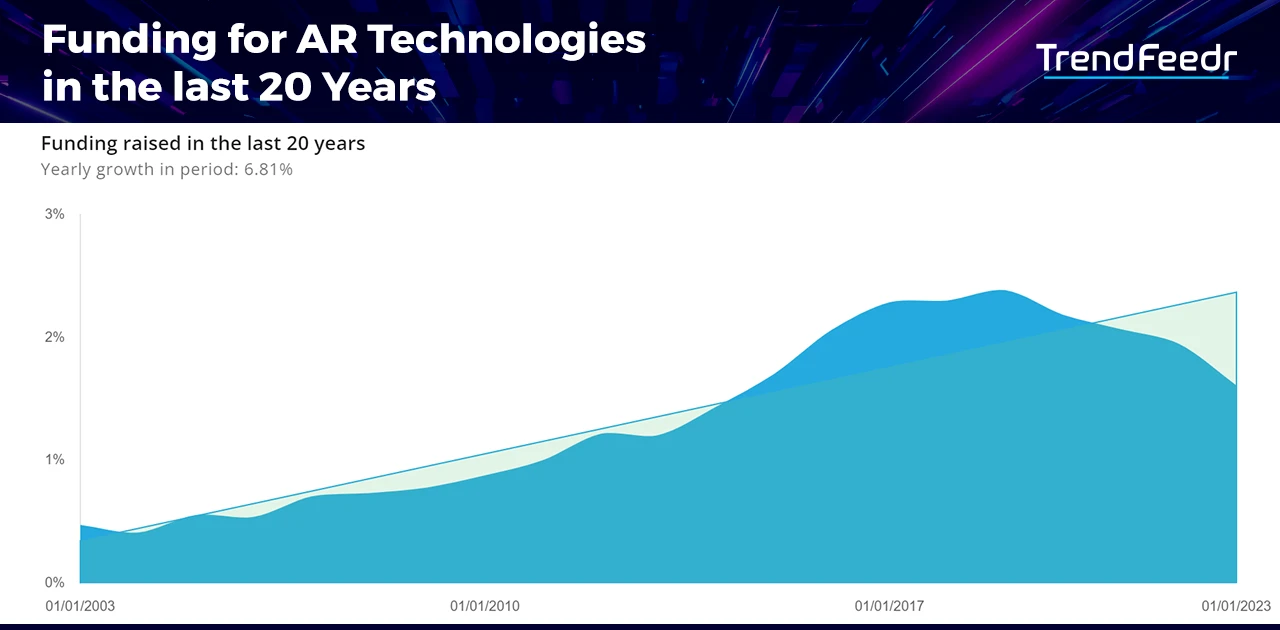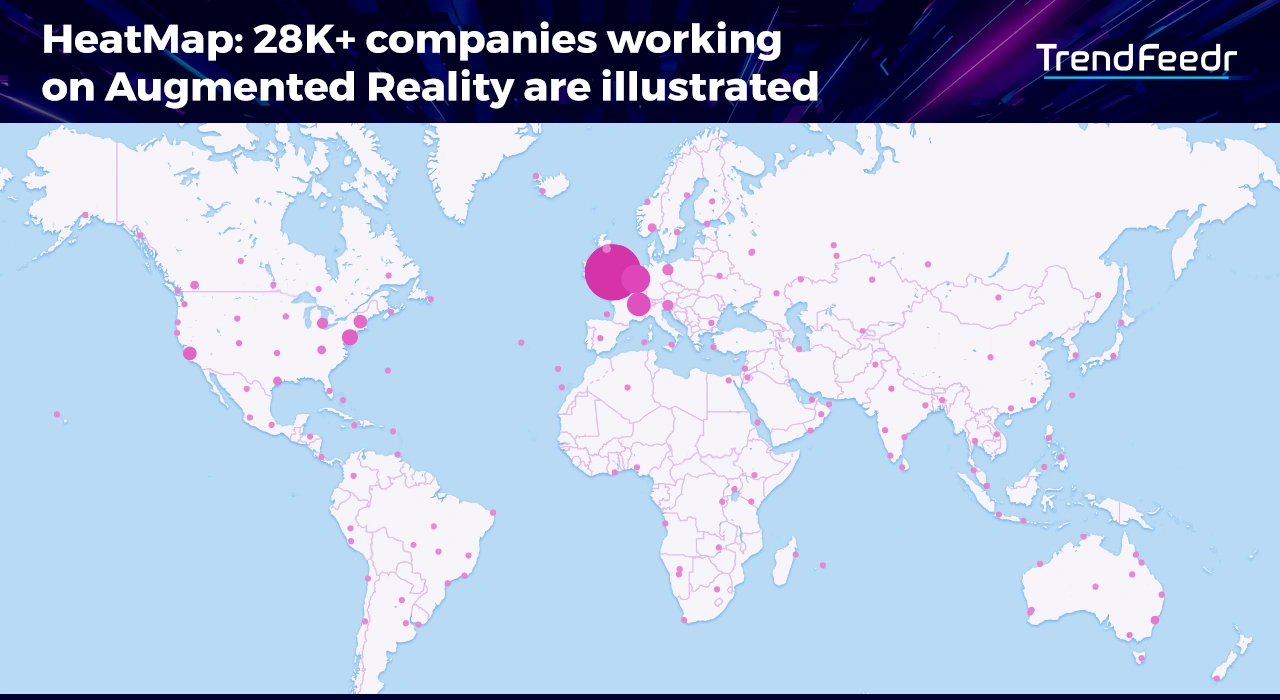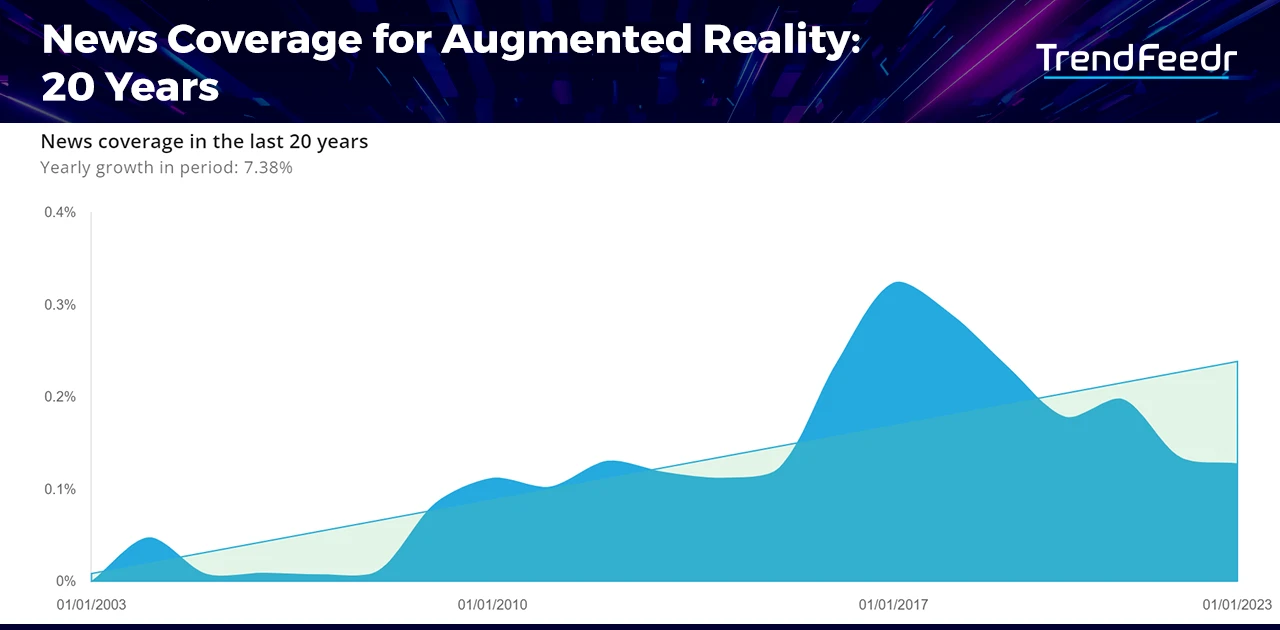In the bustling cityscapes, the simple gesture of pointing one’s smartphone at a local cafe unveils a wealth of information. Instant access to reviews, promotional offers, and even a virtual showcase of the cafe’s menu is now at your fingertips. This transformative experience is brought to life by Augmented Reality (AR) technology. Emerging augmented reality trends further blend the real and virtual worlds to deliver a seamless experience.
Did you know that one-seventh of the entire world’s population already uses AR? Not only this, according to Statista, the number of global AR consumers is expected to grow to 4.3 billion by 2025. By diving deep into augmented reality trends, businesses can position themselves at the forefront of this monumental shift, creating opportunities that are profitable, sustainable, and beneficial for the planet.
Key Takeaways
- Technological Vanguard: With a trend magnitude of 98.92% and a trend maturity of 10.11%, augmented reality is a dominant force in the digital revolution.
- Trend Diversification: Companies operating in the augmented reality space are expanding their focus to include related trends, including wearables, computer vision, 3D AR, spatial audio, and web AR.
- Organizational Landscape & Financial Trajectory: Approximately 28,000 organizations are establishing their presence in the augmented reality sector, collectively attracting funding of around US$82 billion.
- Investment Titans such as Tiger Global Management, Coatue, and Spark Capital are backing the augmented reality movement, investing significant resources into its pioneering initiatives.
- Geographical Trailblazers: Countries like the United States, India, the United Kingdom, Germany, and Canada are leading the charge in augmented reality innovation. Simultaneously, cities like London, New York City, San Francisco, Bangalore, and Los Angeles are buzzing with AR-centric activities and advancements.
- Media Attention: The consistent rise in news coverage over two decades, marked by a 7.38% growth rate, underscores augmented reality’s enduring relevance and public fascination.
Table of Contents
- Understanding Augmented Reality Trends
- AR Trend Card: Capturing its Surge and Significance
- Key Augmented Reality Trends & How Companies are Advancing Them
- How does Augmented Reality Disrupt Industries?
- Pioneering Augmented Reality Organizations
- Augmented Reality Investment Trends
- Mapping Geographical Activity of Augmented Reality Companies
- Annual Media Attention Towards AR
- What is the future of Augmented Reality?
For this comprehensive analysis, we utilize TrendFeedr, our all-in-one trend intelligence platform. TrendFeedr employs advanced algorithms to identify future industry and tech trends. With an emphasis on trend discovery, comparison, and analysis, the AI-powered platform reviews thousands of trends each week and provides actionable insights.
Among the 20,000+ trends and technological evolutions monitored by TrendFeedr, augmented reality has made a notable impact. Here’s why:
- AR secures its place within the top 200 and in the top 2% of global trends, underscoring its significant influence in the ever-evolving landscape of technology.
- With a trend maturity of 10.11%, augmented reality showcases its rapidly progressing development, attracting global enterprises and startups alike.
- The versatility of AR is unparalleled, carving out new avenues that redefine user engagement and experience across industries.
This report discusses various aspects of augmented reality, including performance, investment landscape, emerging companies as well as regional and future trends.
Understanding Augmented Reality Trends
Augmented reality has surfaced as a game-changer in the digital landscape, seamlessly blending the physical and digital worlds to deliver immersive interactive experiences. This revolutionary shift in user interaction is anchored by advanced technologies.
Technology Behind The Trend
At the core of augmented reality is a fusion of several technologies. One of them is computer vision, a technology that interprets and understands visual input from the real world. This aids AR systems in recognizing and processing images and scenes.
Another key technology is 3D scanning, which is essential for creating realistic 3D models. This enables AR systems to accurately overlay digital information on the real-world environment. Additionally, machine learning and AI enhance AR experiences by providing real-time analytics, recognition capabilities, and personalized interactions.
What are the Trends in Augmented Reality?
Among the trends in augmented reality are interactive 3D ads, which engage customers in a new and immersive manner by allowing them to interact with advertisements. Another trend is remote assistance, which facilitates real-time guidance and support from experts, irrespective of geographical boundaries. Additionally, mixed reality (MR) workspaces are gaining traction. These workspaces blend digital and physical elements to foster collaboration and innovation.
Delving deeper, we witness the trend of mobile AR. As smartphones evolve, they serve as an ideal conduit for AR experiences. This transforms mundane interactions into captivating journeys without necessitating additional equipment. On the flip side, AR glasses herald a new era of hands-free and amplified AR experiences. These wearables superimpose digital data directly onto the user’s visual field, paving the way for a more seamless and organic interaction with augmented content.
AR Trend Card: Capturing its Surge and Significance
Presenting the Augmented Reality Trend Card: A succinct journey into the captivating world of AR. Discover the key contributors, groundbreaking technologies, and market dynamics. This snapshot encapsulates crucial data, highlighting the innovations and investments steering the course of AR. Concentrating on the influence of AR across various sectors and geographical regions, this card offers a glimpse into the current highlights, impactful articles, and narratives shaping the landscape. Gain insights into the momentum within the AR sphere and understand how media plays a pivotal role in its widespread adoption.
Exhibiting a remarkable annual growth rate of 9.78% and a trend magnitude peaking at 98.92%, AR confidently secures its position within the top 2% of global trends. Its maturity index, standing strong at 10.11%, further underscores its robust evolution and untapped potential for future expansion.
This snapshot provides an enticing glimpse into the world of AR. However, the subsequent sections of this report go deeper, exploring the intricate dynamics that are catapulting AR to the forefront of technological innovation.
Looking for all trends related to augmented reality?
Key Augmented Reality Trends & How Companies are Advancing Them
The vibrancy of the AR ecosystem extends beyond its fundamental capabilities, encompassing a variety of supplementary trends that amplify and enrich the immersive experiences AR offers. Let’s explore the diverse trends that augmented reality companies are advancing:
1. Wearables
- These are devices and technologies designed to be worn on the body, often as accessories, to enhance user experiences through integration with digital services.
- A total of 95.2K organizations have plunged into the wearables trend, amassing a staggering US$190.7 billion in funding.
- This massive trend is fueled by a robust workforce of 5.5 million experts dedicated to refining and innovating wearable technology.
2. Computer Vision
- This is the science that enables machines to interpret and make decisions based on visual data, mimicking the capabilities of human vision but at a much larger scale and speed.
- A significant 24.6K organizations have placed their bets on computer vision, securing an impressive US$91.7 billion in investment.
- Powering these endeavors is a workforce of 1.4 million professionals, pushing the boundaries of what machines can ‘see’ and ‘understand’.
3. 3D AR
- These are augmented reality experiences that project 3D objects and entities into the real world, offering an enhanced level of depth and interactivity.
- With 706 organizations deeply involved in 3D AR development, they’ve managed to draw US$1.7 billion in funding.
- Ensuring the quality and innovation in this segment is a dedicated workforce of 18.5K specialists.
4. Spatial Audio
- This sound technology allows audio to exist as three-dimensional objects in a digital space, making virtual environments more immersive and realistic.
- A count of 334 organizations have tapped into the potential of spatial audio, acquiring a commendable US$2.7 billion in funding.
- Behind the auditory magic are 13.1K experts, fine-tuning the way we hear and experience sound in virtual domains.
5. WebAR
- This is the fusion of AR experiences directly within web browsers, eliminating the need for dedicated applications or software.
- A growing number of 372 organizations are venturing into WebAR, securing a total of US$327.5 million in financial backing.
- Fueling this web-centric approach to AR is a skilled group of 6,973 professionals, making AR experiences more accessible and widespread.
Whether it’s making machines more visually intelligent or making digital sound more lifelike, the fusion of AR with these trends is set to redefine digital experiences.
How does Augmented Reality Disrupt Industries?
Augmented Reality is making waves across various sectors, leaving an indelible mark with its innovative applications. Each industry is tapping into the power of AR to transform its operations, user experiences, and service offerings. Let’s delve into some of the sectors that have been most significantly influenced by AR, accompanied by illustrative examples:
Retail
Retailers are harnessing AR to enrich customer shopping experiences. From virtual try-ons for clothing or eyewear to visualizing furniture in one’s space before purchase, AR bridges the gap between online shopping and the tactile in-store experience.
For example, Lily, a Chinese women’s wear brand, set up an interactive pop-up store, where passengers use AR to virtually try on clothes by inputting their height, weight, and a selfie. The system would then generate the outfit, which could be downloaded via a QR code.
Healthcare
AR finds its application in surgery simulations, patient care, and medical training. Surgeons overlay virtual 3D reconstructions of complex organs to enhance precision. Moreover, AR aids in visualizing intricate procedures, assisting medical professionals in their training.
For instance, Augmedics develops xvision Spine System that provides surgeons with an unprecedented view of patient anatomy, akin to “x-ray vision”. It enhances precision in navigating instruments and implants during spinal procedures, marking a significant leap forward in surgical capabilities.
Real Estate
Real estate agents and firms are using AR to offer virtual property tours, allowing potential buyers to walk through properties from the comfort of their homes. Moreover, users visualize renovations and changes to the property in real time using AR tools, aiding in their purchase decisions.
Companies like RealAR leverage both AR and AI to transform floor plans into interactive walkthroughs that can be utilized onsite and remotely. It serves as a valuable tool for home sales consultants, real estate agents, and building professionals, enabling them to fully comprehend floor plans and building designs.
Automotive
Car manufacturers are integrating AR into their designs for enhanced user experiences. AR dashboards overlay critical information, reducing the need for drivers to look away from the road.
For example, BMW has introduced AR manuals, allowing users to point their devices at parts of their cars to receive real-time information and tutorials. Further, automobile companies like Mitsubishi Motors have created virtual showrooms, allowing customers to explore different car models.
Education
AR in education is making learning more interactive and engaging. From visualizing complex scientific concepts to historical recreations, AR provides students with a hands-on experience, making abstract ideas more tangible. Apps that overlay information on landmarks or museums are transforming field trips, making them more informative and immersive.
Assemblr, for instance, is an EdTech platform that allows teachers and students to create more interactive, collaborative, and fun learning activities with 3D and AR.
Across these sectors and beyond, AR is continually redefining what’s possible and setting a precedent for future innovations.
Pioneering Augmented Reality Organizations
The graph above illustrates the rising number of organizations in the AR industry. With an annual growth rate of 6.62% spanning the last 20 years, it’s clear that businesses, startups, and enterprises are acknowledging the potential of AR.
Augmented reality startups are redefining retail experiences, transforming them into immersive journeys, and turning educational tools into advanced learning platforms. They are also creating dynamic gaming landscapes and enhancing workplace training. Let’s get into five top AR startups established in the last five years and explore their contributions to the evolution of augmented experiences.
- Eterio Realities: Developer of FabStation, a software that leverages AR to revolutionize steel production by boosting efficiency and precision.
- Augmenteers: Operator of a platform that combines AR and 3D technology, enabling online retailers to manage their product portfolio, scrutinize usage patterns, and enhance their visual presentations.
- RouteMe: Developer of an AR-based indoor navigation system that transforms the way customers, shoppers, and passengers navigate by offering turn-by-turn directions.
- Cityscaper: Provider of AR-based software that brings architectural visions to life, enabling users to visualize pre-constructed structures and future projects in their actual locations.
- HoloMetrix: Developer of a software platform for acoustic measurements that harnesses AR and projects a virtual measurement grid in 3D within the real measurement environment.
Turning our attention to the workforce driving AR forward, the total number of professionals in the field is currently at 1.1 million. With an average team size of 53 and a median of 11, it’s clear that organizations differ in scale, yet each one plays a crucial role in propelling the AR trend forward. In terms of employee growth, the annual total stands at 124.6K, with an average and median growth rate of 7 and 3, respectively, signifying a consistent expansion of talent.
Augmented Reality Investment Trends
From a financial perspective, the total augmented reality funding is within the top 5% of all 20K+ trends covered by TrendFeedr.
Moreover, the past two decades saw an average annual funding growth rate of 6.81%, signifying a continual stream of financial support fueling this technology trend. This financial trajectory showcases significant momentum, positioning AR as an attractive field for both investors and innovators.
Examining the Financial Details
According to data from TrendFeedr, AR has seen total funding of US$82.1 billion since 2000, underscoring substantial financial backing. The highest funding for a single entity peaked at an impressive US$1.4 billion for Face++, with an average and median funding of US$15 million and US$1.3 million respectively. Further, TrendFeedr estimates a total revenue of US$158.2 billion, with a maximum revenue of US$500 million, averaging US$7.5 million and a median of US$1.8 million.
Interestingly, 19.44% of all augmented reality companies have received investments through a variety of funding rounds. The seed stage is a critical phase for startups, offering them the initial capital needed to launch their ventures. This is typically followed by Early Stage VC or Series A funding rounds, which enable companies that have shown promise to scale their operations and refine their products. Accelerator and Incubator programs are instrumental in this process, providing mentorship, resources, and occasionally funding to aid startups in navigating the challenging early stages of their journey. Interestingly, 3.49% of companies in the augmented reality space have received a total of 1480 grants, highlighting the availability of non-equity assistance. Lastly, Pre-Seed funding, although usually smaller in size, is vital as it supports entrepreneurs during the ideation and development stage, setting the foundation for future success.
Finally, the wide array of unique investors for augmented reality deserves recognition, as it ranks within the top 5% of all trends. This highlights the extensive interest and investment diversity in the AR domain.
Key Financial Supporters of Augmented Reality
Among the top investors, Tiger Global Management shines with a significant contribution of US$728.1 million, invested across 14 companies. Notably, Physna received US$56 million of this investment, underlining their prominent roles in the AR arena.
In another development, Coatue has made considerable progress with a total investment of US$600 million distributed across five ventures. Among these, Rec Room and Agora lead with investments of US$145 million and US$70 million respectively, demonstrating their potential in harnessing AR to transform their sectors.
Furthermore, Spark Capital‘s participation is significant with a total investment of US$486 million across four companies, further strengthening the AR ecosystem. Their primary investments were directed towards Niantic, with US$200 million, emphasizing the diverse utility of AR technologies.
The broader investment landscape also displays an impressive sum of US$873.8 million in public investments across 31 entities. At the forefront are companies like Visang with US$56 million, showcasing the extensive financial support AR continues to receive in the public sector.
Mapping Geographical Activity of Augmented Reality Companies
The heatmap below provides a comprehensive overview of the 28K+ enterprises globally that are pioneering the augmented reality landscape.
Interested to explore all 28K+ AR companies?
Among the leading countries, the United States stands out in nurturing AR innovations, thanks to its advanced technological infrastructure and a robust ecosystem of investors and developers. Following closely is India which undergoes rapid digital transformation and boasts burgeoning tech-savvy populations, making it an ideal breeding ground for AR advancements. The United Kingdom is emerging as a dynamic player, boasting a vibrant ecosystem of both startups and established firms, each exploring a myriad of applications in this cutting-edge field. Further, Canada and Germany play significant roles, each contributing a unique mix of technical expertise and industry-specific AR applications, enriching the global AR landscape.
When it comes to cities, New York City, a melting pot of numerous industries, has adopted AR to revolutionize traditional business operations and consumer interactions. London’s well-established status as a tech innovation hub is evident in its active participation in AR research and development. On the West Coast, cities like San Francisco and Los Angeles leverage their tech-centric cultures to support AR startups and promote innovative AR applications. Lastly, Bangalore, emerges as a strong advocate of AR, with a multitude of companies exploring and implementing AR solutions to tackle a wide range of challenges.
Annual Media Attention Towards AR Grows by 7.38% over the Past Twenty Years
Over the past two decades, the annual growth rate for augmented reality news coverage has been at a notable 7.38%, as the figure above shows. This underscores AR’s significance and its enduring momentum in capturing headlines and sparking conversations.
Moreover, augmented reality is creating a significant impact in the sphere of publication coverage, securing a position within the top 5% growth bracket. This encompasses a wide array of technology, innovation, and startup-focused publications that have prominently featured this trend. In terms of content volume, articles focusing on augmented reality hold a distinguished spot within the top 5% of all trends. Specifically, from 2006 to 2023, an impressive total of 101,762 articles have been written about this transformative technology.
What is the future of Augmented Reality?
In the fast-changing tech world, augmented reality trends promise transformative experiences and reshaped interactions. Here’s a glimpse into augmented reality future trends:
Ubiquitous Integration
Looking ahead, AR is set to become an indispensable part of everyday lives, effortlessly merging digital data with the physical environment. We can anticipate a widespread integration of AR across various sectors such as education, healthcare, retail, and industrial maintenance. Through wearable AR devices, mobile AR applications, and AR-enhanced platforms, interaction with the world is poised to undergo a transformation, enriching experiences with a layer of contextual digital information.
Advanced Hardware
The progression of AR-specific hardware like AR glasses and headsets will significantly amplify AR experiences. With tech behemoths like Apple, Google, and Microsoft pouring substantial investments into AR hardware, we can look forward to more advanced, lightweight, and user-friendly devices entering the market. These advances in hardware technology will deliver superior AR experiences and also make AR more accessible to a wider audience.
Improved Connectivity
The deployment of 5G and subsequent generations of network connectivity are pivotal for real-time AR applications. Enhanced network speeds and reduced latencies will facilitate more robust and responsive AR applications, particularly in scenarios necessitating real-time data overlay and interactions.
Extended Reality (XR)
The amalgamation of AR with virtual reality (VR) and mixed reality (MR) will pave the way for the broader adoption of XR. XR, as a unified experience platform, could redefine digital interactions and unlock new realms of possibilities in simulation, training, entertainment, and remote collaboration.
Ethical and Privacy Concerns
As AR becomes more ingrained in our lives, ethical and privacy concerns will take center stage. Issues surrounding data security, personal privacy, and the potential for augmented reality to distort truth or reality necessitate careful consideration and regulatory frameworks to ensure responsible and ethical deployment of AR.
The trajectory of AR is undeniably thrilling, holding the promise of ushering in a new era of interactive and immersive experiences. With continual advancements in technology and a growing ecosystem of developers, creators, and innovators, the future outlook for AR is bright and brimming with potential.
Navigating the Expanding Universe of Augmented Reality
As we conclude, it is evident that the augmented reality market is expanding at an unprecedented rate. It unveils innovative ways for users to engage with the digital enhancement of the physical world. AR is transforming everything from shopping experiences to gaming and training modules, becoming an integral part of everyday lives. With its potential to change how we interact with digital data, groundbreaking developments are charting the path towards a reality enhanced beyond the realms of science fiction.
For those who aspire to lead in this technological upheaval, staying informed is crucial. But how can you stay ahead? Immerse yourself in AR-focused publications, participate in forums dedicated to AR discourse, learn from the wisdom of industry pioneers, and ensure your presence at AR-specific expos and conferences. Utilizing a trend intelligence tool like TrendFeedr is invaluable, as it tracks up to 80 AR sub-trends, providing a holistic view of minor shifts and major strides in the AR sphere.
By delving into the latest trends in augmented reality, you empower yourself to create forward-thinking strategies and experiences that align with the evolving demands of the future.


